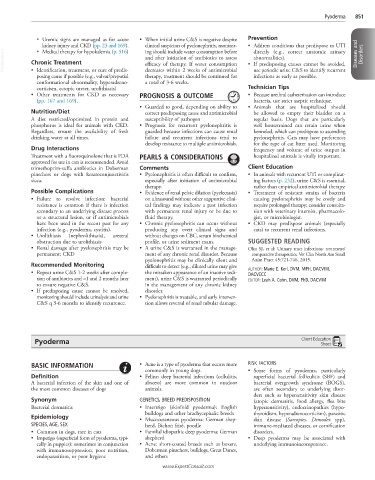Page 1691 - Cote clinical veterinary advisor dogs and cats 4th
P. 1691
Pyoderma 851
○ Uremic signs are managed as for acute • When initial urine C&S is negative despite Prevention
kidney injury and CKD (pp. 23 and 169). clinical suspicion of pyelonephritis, monitor- • Address conditions that predispose to UTI
VetBooks.ir Chronic Treatment and after initiation of antibiotics to assess • If predisposing causes cannot be avoided, Diseases and Disorders
○ Medical therapy for hypokalemia (p. 516)
directly (e.g., correct anatomic urinary
ing should include water consumption before
abnormalities).
efficacy of therapy. If water consumption
• Identification, treatment, or cure of predis-
posing cause if possible (e.g., vulvar/preputial decreases within 2 weeks of antimicrobial use periodic urine C&S to identify recurrent
infections as early as possible.
therapy, treatment should be continued for
conformational abnormality, hyperadreno- a total of 3-6 weeks.
corticism, ectopic ureter, urolithiasis) Technician Tips
• Other treatments for CKD as necessary PROGNOSIS & OUTCOME • Because urethral catheterization can introduce
(pp. 167 and 169). bacteria, use strict aseptic technique.
• Guarded to good, depending on ability to • Animals that are hospitalized should
Nutrition/Diet correct predisposing cause and antimicrobial be allowed to empty their bladder on a
A diet restricted/optimized in protein and susceptibility of pathogen regular basis. Dogs that are particularly
phosphorus is ideal for animals with CKD. • Prognosis for recurrent pyelonephritis is well housetrained can retain urine when
Regardless, ensure the availability of fresh guarded because infections can cause renal kenneled, which can predispose to ascending
drinking water at all times. failure and recurrent infections tend to pyelonephritis. Cats may have preferences
develop resistance to multiple antimicrobials. for the type of cat litter used. Monitoring
Drug Interactions frequency and volume of urine output in
Treatment with a fluoroquinolone that is FDA PEARLS & CONSIDERATIONS hospitalized animals is vitally important.
approved for use in cats is recommended. Avoid
trimethoprim-sulfa antibiotics in Doberman Comments Client Education
pinschers or dogs with keratoconjunctivitis • Pyelonephritis is often difficult to confirm, • In animals with recurrent UTI or complicat-
sicca. especially after initiation of antimicrobial ing factors (p. 232), urine C&S is essential,
therapy. rather than empirical antimicrobial therapy.
Possible Complications • Evidence of renal pelvic dilation (pyelectasia) • Treatment of resistant strains of bacteria
• Failure to resolve infection: bacterial on ultrasound without other supportive clini- causing pyelonephritis may be costly and
resistance is common if there is infection cal findings may indicate a past infection require prolonged therapy; consider consulta-
secondary to an underlying disease process with permanent renal injury or be due to tion with veterinary internist, pharmacolo-
or a structural lesion, or if antimicrobials fluid therapy. gist, or microbiologist.
have been used in the recent past for any • Chronic pyelonephritis can occur without • CKD may predispose animals (especially
infection (e.g., pyoderma, cystitis). producing any overt clinical signs and cats) to recurrent renal infections.
• Urolithiasis (nephrolithiasis), ureteral without changes on CBC, serum biochemical
obstruction due to urolithiasis profile, or urine sediment exam. SUGGESTED READING
• Renal damage after pyelonephritis may be • A urine C&S is warranted in the manage- Olin SJ, et al: Urinary tract infections: treatment/
permanent; CKD ment of any chronic renal disorder. Because comparative therapeutics. Vet Clin North Am Small
pyelonephritis may be clinically silent and Anim Pract 45:721-746, 2015.
Recommended Monitoring difficult to detect (e.g., diluted urine may give
• Repeat urine C&S 1-2 weeks after comple- the mistaken appearance of an inactive sedi- AUTHOR: Marie E. Kerl, DVM, MPH, DACVIM,
DACVECC
tion of antibiotics and ≈1 and 2 months later ment), urine C&S is warranted periodically EDITOR: Leah A. Cohn, DVM, PhD, DACVIM
to ensure negative C&S. in the management of any chronic kidney
• If predisposing cause cannot be resolved, disorder.
monitoring should include urinalysis and urine • Pyelonephritis is treatable, and early interven-
C&S q 3-6 months to identify recurrence. tion allows reversal of renal tubular damage.
Pyoderma Client Education
Sheet
BASIC INFORMATION • Acne is a type of pyoderma that occurs more RISK FACTORS
commonly in young dogs. • Some forms of pyoderma, particularly
Definition • Feline: deep bacterial infections (cellulitis, superficial bacterial folliculitis (SBF) and
A bacterial infection of the skin and one of abscess) are more common in outdoor bacterial overgrowth syndrome (BOGS),
the most common diseases of dogs animals. are often secondary to underlying disor-
ders such as hypersensitivity skin disease
Synonym GENETICS, BREED PREDISPOSITION (atopic dermatitis, food allergy, flea bite
Bacterial dermatitis • Intertrigo (skinfold pyoderma): English hypersensitivity), endocrinopathies (hypo-
bulldogs and other brachycephalic breeds thyroidism, hyperadrenocorticism), parasitic
Epidemiology • Mucocutaneous pyoderma: German shep- skin disease (Sarcoptes, Demodex spp),
SPECIES, AGE, SEX herd, Bichon frisé, poodle immune-mediated diseases, or cornification
• Common in dogs, rare in cats • Familial idiopathic deep pyoderma: German disorders.
• Impetigo (superficial form of pyoderma, typi- shepherd • Deep pyoderma may be associated with
cally in puppies): sometimes in conjunction • Acne: short-coated breeds such as boxers, underlying immunoincompetence.
with immunosuppression, poor nutrition, Doberman pinschers, bulldogs, Great Danes,
endoparasitism, or poor hygiene and others
www.ExpertConsult.com

